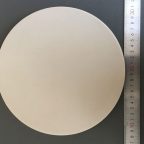Industrial ceramics are widely used due to their high wear resistance, high hardness, and especially excellent insulating properties.
Insulating porcelain, also known as device porcelain, is widely used in electrical equipment. Commonly used products are: high-frequency insulators, sockets, porcelain shafts, porcelain tubes, substrates, band switches, etc.
Zirconia Industrial Ceramic Parts
The basic requirements for insulating porcelain are low dielectric constant ε, small dielectric loss tanδ, high insulation resistivity ρ, high breakdown strength E, and good dielectric temperature characteristics and frequency characteristics. In addition, high mechanical strength and chemical stability are also required.
Insulation porcelain mainly refers to porcelain products used for installation, fixation, support, protection, insulation, isolation and connection of various electronic components and devices. The basic requirements for insulating porcelain are:
- ① High volume resistivity (usually required to be greater than 10mn cm at room temperature) and high dielectric strength (greater than 10. kV/m) to reduce leakage conduction losses and withstand high voltages.
- ② Relative to the use of capacitors, the dielectric constant is small, and it is generally required to account for ≤ 9. Otherwise, the distributed capacitance of the line is too large, which will affect the line parameters and the quality of the whole machine. In addition, when s is small, the dielectric loss is also small.
- ③ The dielectric loss is small at high frequency, and tg8 is generally 2×10—9×10. range to reduce heat generation during work.
- ④High mechanical strength, the flexural strength is generally 45-300 MPa, and the compressive strength is 400-2000 MPa.
- ⑤Good chemical stability.
Insulated Porcelain Tube
There are many types of insulating porcelain bodies, and those widely used in industry can be divided into two series:
- ①Clay system (Al:O, one SiC): system), including corundum porcelain, corundum-mullite porcelain and mullite porcelain.
- ②Talc series (MgO—Al: O, one SiO: system), including block talc porcelain, forsterite porcelain, spinel porcelain and cordierite porcelain
Pintejin machining ceramic service include : Alumina Ceramic Parts, Zirconia Ceramic, Silicon Carbide Ceramic, CNC Machined Aluminum Nitride Ceramic, Machinable Ceramic Parts, Glass Ceramic,Macor Ceramic,Powder Metallurgy Dies,Ceramic Injection Molding,Ceramic Dry Pressing,Ceramic Extrusion Dies




